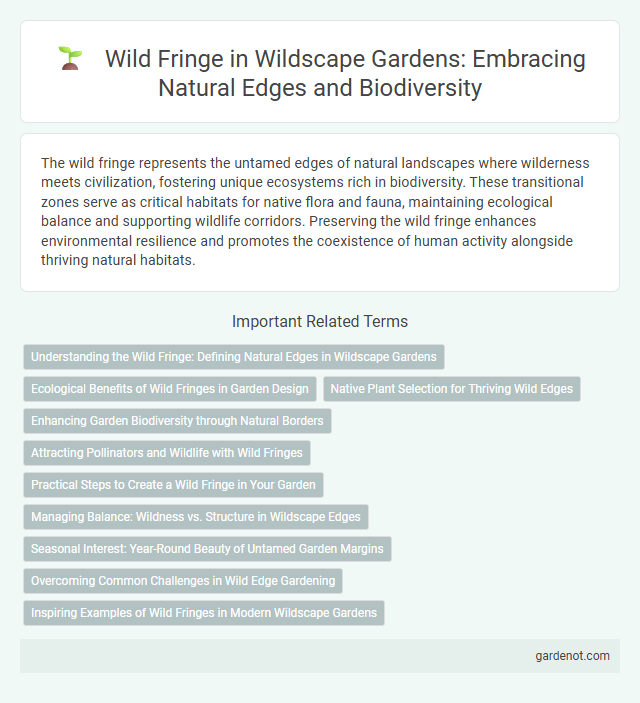The wild fringe represents the untamed edges of natural landscapes where wilderness meets civilization, fostering unique ecosystems rich in biodiversity. These transitional zones serve as critical habitats for native flora and fauna, maintaining ecological balance and supporting wildlife corridors. Preserving the wild fringe enhances environmental resilience and promotes the coexistence of human activity alongside thriving natural habitats.
Understanding the Wild Fringe: Defining Natural Edges in Wildscape Gardens
The wild fringe in Wildscape gardens represents the natural transitional zones where cultivated areas meet untamed wilderness, fostering biodiversity and ecological balance. These edges provide critical habitats for pollinators, birds, and small mammals, enhancing ecosystem resilience and promoting native plant growth. Managing wild fringes involves using native species and minimal human interference to sustain natural processes and improve habitat connectivity.
Ecological Benefits of Wild Fringes in Garden Design
Wild fringes in garden design enhance biodiversity by providing essential habitats for pollinators, birds, and beneficial insects, contributing to ecosystem stability. These vegetative buffers improve soil health through erosion control and organic matter accumulation, promoting sustainable plant growth. Incorporating wild fringes supports natural pest regulation, reducing the need for chemical interventions and fostering a balanced garden ecosystem.
Native Plant Selection for Thriving Wild Edges
Wild fringe areas thrive by selecting native plants that support local biodiversity and soil health. Species like goldenrod, milkweed, and purple coneflower provide essential habitats for pollinators and contribute to ecological resilience. Prioritizing native flora ensures sustainable wild edges that enhance ecosystem functions and aesthetic value.
Enhancing Garden Biodiversity through Natural Borders
Wild fringes serve as vital natural borders that enhance garden biodiversity by providing habitats for pollinators, birds, and beneficial insects. These edges support native plant growth, promote soil health, and foster ecological balance within garden ecosystems. Establishing wild fringes creates a sustainable environment that encourages wildlife proliferation and strengthens garden resilience.
Attracting Pollinators and Wildlife with Wild Fringes
Wild fringes play a crucial role in attracting pollinators and diverse wildlife by providing an abundance of native flowering plants, rich nectar sources, and shelter. These areas enhance biodiversity, supporting bees, butterflies, birds, and beneficial insects essential for ecosystem health. Creating wild fringes around gardens or landscapes promotes pollination, natural pest control, and strengthens local wildlife habitats.
Practical Steps to Create a Wild Fringe in Your Garden
Creating a wild fringe in your garden involves planting native grasses, wildflowers, and shrubs that provide habitat for pollinators and wildlife. Choose species suited to your local climate and soil conditions to ensure sustainability and low maintenance. Regularly monitor plant growth and avoid using chemicals to maintain a thriving, natural ecosystem at the garden's perimeter.
Managing Balance: Wildness vs. Structure in Wildscape Edges
Wild fringes in wildscape edges serve as crucial transitional zones where the tension between wildness and structured habitats is carefully managed to promote biodiversity. These areas support diverse species by providing refuge and connecting core wilderness with more controlled landscapes, maintaining ecological resilience. Effective management balances natural processes like succession and disturbance with intentional interventions, ensuring the fringe remains both dynamic and accessible.
Seasonal Interest: Year-Round Beauty of Untamed Garden Margins
Wild fringes transform garden margins into dynamic habitats that burst with seasonal interest, showcasing a diverse palette of native flora throughout the year. In spring, vibrant wildflowers like bluebells and primroses carpet the edges, while summer brings a profusion of pollinator-attracting blooms such as wild chamomile and oxeye daisies. Autumn and winter reveal structural elements like dried grasses and seed heads that provide essential food and shelter for wildlife, ensuring continuous ecological value and year-round beauty in untamed garden borders.
Overcoming Common Challenges in Wild Edge Gardening
Wild edge gardening at the wild fringe often faces challenges such as soil erosion, invasive species, and water scarcity. Effective strategies include planting native deep-rooted plants to stabilize soil, regularly monitoring and removing invasive species, and utilizing rainwater harvesting to maintain consistent moisture. Emphasizing biodiversity and adaptive management promotes resilience and natural balance in wild edge ecosystems.
Inspiring Examples of Wild Fringes in Modern Wildscape Gardens
Wild fringes in modern wildscape gardens showcase a vibrant blend of native grasses, wildflowers, and pollinator-friendly plants that create naturalistic edges supporting biodiversity. These dynamic borders provide essential habitats for birds, bees, and butterflies, enhancing ecosystem connectivity while adding texture and movement to garden design. Incorporating species like Echinacea purpurea, Andropogon gerardii, and Asclepias tuberosa, these examples inspire sustainable landscaping with ecological and aesthetic benefits.
Wild fringe Infographic

 gardenot.com
gardenot.com